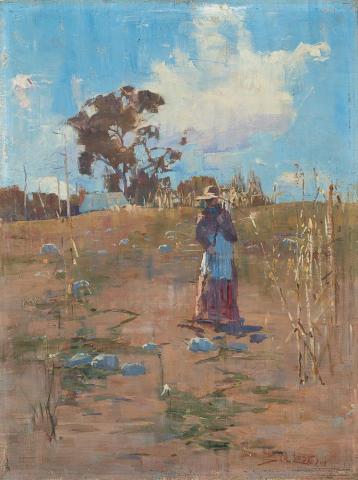THE PUMPKIN PATCH, 1895
SYDNEY LONG
oil on wood panel
40.0 x 30.0 cm
signed and dated lower right: Sid Long / 95
Private collection, Sydney
Company collection, Sydney
The Society of Artists. First Exhibition, York Street Rink, Sydney, 28 September 1895, cat. 3
Catalogue First Exhibition By the Society of Artists, Sydney, 1895, cat. 3
Mendelssohn, J., The Life and Work of Sydney Long, McGraw-Hill, Sydney, 1979, cat. 26, p. 227
Sydney Long’s The Pumpkin Patch, 1895 heralds the emergence of a style singular in Australian art. Included in the Sydney Society of Artists inaugural exhibition of September 1895, the exhibition was grand in scale, numbering over two hundred works by many of Australia’s then leading artists. Chief among the masterpieces on show were Tom Roberts’ iconic Bailed Up and Arthur Streeton’s Cremorne Pastoral, 1895 (both in the collection of the Art Gallery of New South Wales, Sydney). The latter was hailed as ‘… one of the finest pictures of the year’.1 Streeton exhibited twelve works, followed closely by Long, who showed a handsome group of eleven. Of Long’s work, the same critic noted that the ‘…great canvas entitled “Summer,” [was] somewhat excitedly coloured …, but yet not without the effects which only talent can achieve’. 2
The exhibition also included Long’s In the Spring, c.1895 (Newcastle Art Gallery, New South Wales), like The Pumpkin Patch in depicting a single woman within the landscape, vertical of composition and painted on a wood panel. Long’s Feeding Time, c.1896 (National Gallery of Australia, Canberra), another work related in subject and style, was included in the Society of Artists’ exhibition of the following year. The location for all three is thought to be on or near Griffith’s farm near the Hawkesbury River at North Richmond. It was an area of great appeal inspiring many major works of the like of Charles Conder’s Springtime, 1888 (National Gallery of Victoria, Felton Bequest) and Streeton’s The Purple Noon’s Transparent Might, 1896, again in the National Gallery of Victoria and purchased in the year it was painted. What is so striking about Long’s three paintings is their all-pervasive calm. Stillness is palpable. Winter morning, a sparkling spring day, or high noon, nothing moves. Even the feeding chooks and calves are fixed in a moment of time, as stillness becomes the subject itself. In the crisp, clear air the verticals, single and sensuous, take their first tentative steps towards Art Nouveau. The added rural charm of simplicity and domesticity is watched over in each by the female figure, the nurturing woman. As further welcome harbingers, there is just a touch of that dreamy mood which permeates so much of Long’s later art. In Spirit of the Plains, 1897 (Queensland Art Gallery, Brisbane) the female figure became the piping nymph, or devotees of Pan in the dream-like mythologising Pan, 1898 (Art Gallery of New South Wales). Symbolist masterpieces, blending the modern with the mythological, they celebrate the beauty of the poetic in the Australian landscape, lyrical evocations of an Antipodean Arcadia.
1. ‘The Society of Artists’ Exhibition’, Sydney Morning Herald, 27 September 1895, p. 2. Tom Roberts was the Society’s Chairman, and Streeton and Long were members of the Council. In his speech at the Society’s inaugural dinner, Roberts announced the bequest of £50 by Mr Richard Wynne for an annual prize for landscape painting, marking the beginning of the Wynne Prize organized by the Art Gallery of New South Wales.
2. Ibid.
DAVID THOMAS
